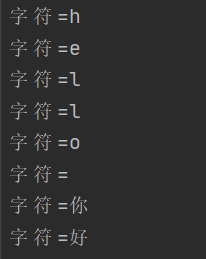字符串常用系统函数
- 统计字符串的长度,len
- 遍历字符,并处理中文 r := []rune(s)
- 字符串转整数
- 整数转字符串
- 字符串转 []byte
- []byte转字符串
- 十进制转其它进制数字
- 字符串是否包含某子串
- 统计在字符串中出现子串的次数
- 不区分大小写比较
- 子串在母串第一次出现的索引位置(从0开始)
- 子串在母串最后一次出现的位置索引
- 字符串替换 replace
- 字符串切割
- 大小写转换
- 去除左右空格 TrimSpace
- 去除左右两端指定的字符 strings.Trim
- 去除左端指定字符 strings.TrimLeft
- 去除右端指定字符 strings.TrimRight
- 字符串是否已指定字符串开头 strings.HasPrefix
- 字符串是否以指定字符串结尾 strings.HasSuffix
在平时字符串的使用频率是非常高的,那么有哪些函数式我们经常要用到的呢,在这里为大家整理以下。
统计字符串的长度,len
var s string = "hello world"
var s2 string = "你好"
fmt.Println(len(s))// 11
fmt.Println(len(s2))//6 中文字符在unicode下占2个字节,在utf-8编码下占3个字节,而golang默认编码正好是utf-8
注意: len是按字节数计算的
遍历字符,并处理中文 r := []rune(s)
var s3 string = "hello 你好"
runes := []rune(s3)
for i := 0; i < len(runes); i++{
fmt.Printf("字符=%c\n",runes[i])
}

字符串转整数
var s4 string = "123"
num, err := strconv.Atoi(s4)
if err != nil {
panic(err)
}
fmt.Printf("num type is %T, value = %v\n",num,num)
// num type is int, value = 123
整数转字符串
var num1 int = 66
str := strconv.Itoa(num1)
fmt.Printf("str type is %T, value = %q\n",str,str)
// str type is string, value = "66"
字符串转 []byte
var s5 string = "hello"
bytes := []byte(s5)
fmt.Printf("bytes = %v ",bytes)

这里把字符转为相对应的ASCII码
[]byte转字符串
s6 := string([]byte{97,98,99})
fmt.Printf("s6 = %v\n",s6) // s6 = abc
十进制转其它进制数字
var num3 int64 = 10
// 想转换成 xx进制,就把第二个参数写成几,例如二进制2,八进制8,十六进制16
formatInt := strconv.FormatInt(num3, 2)
fmt.Printf("对应的2进制数字: %v\n",formatInt)
// 对应的2进制数字: 1010
字符串是否包含某子串
boo := strings.Contains("hello 你好", "你好")
fmt.Printf("是否包含: %v\n",boo)// true
统计在字符串中出现子串的次数
count := strings.Count("hello", "l")
fmt.Printf("出现次数: %v\n",count) // 2
如果没有出现返回 0,否则 返回 大于0的数
不区分大小写比较
fmt.Println(strings.EqualFold("abc","Abc")) // true
== 是区分大小写的比较
子串在母串第一次出现的索引位置(从0开始)
没有出现就返回 -1
fmt.Println(strings.Index("first blood","ood")) // 8
fmt.Println(strings.Index("first blood","oodm")) // -1
子串在母串最后一次出现的位置索引
没有则返回 -1
fmt.Println(strings.LastIndex("go golang","go")) // 3
fmt.Println(strings.LastIndex("go golang","gog")) // -1
字符串替换 replace
func Replace(s, old, new string, n int) string
返回将s中前n个不重叠old子串都替换为new的新字符串,如果n<0会替换所有old子串。
fmt.Println(strings.Replace("hello,world,hello,world","world","go",1)) // hello,go,hello,world
fmt.Println(strings.Replace("hello,world,hello,world","world","go",-1)) // hello,go,hello,go
字符串切割
func Split(s, sep string) []string
用去掉s中出现的sep的方式进行分割,会分割到结尾,并返回生成的所有片段组成的切片(每一个sep都会进行一次切割,即使两个sep相邻,也会进行两次切割)。如果sep为空字符,Split会将s切分成每一个unicode码值一个字符串。
var s7 string = "hello,world"
split := strings.Split(s7, ",")
fmt.Println(split) // [hello world]
大小写转换
大写转小写 ToLower
小写转大写 ToUpper
fmt.Println(strings.ToLower("GO")) // go
fmt.Println(strings.ToUpper("go")) // GO
去除左右空格 TrimSpace
s8 := strings.TrimSpace("hello ")
fmt.Printf("%q\n",s8) // "hello"
去除左右两端指定的字符 strings.Trim
func Trim(s string, cutset string) string
返回将s前后端所有cutset包含的utf-8码值都去掉的字符串。
s9 := strings.Trim(" ! hello world 123 !", "! ")// 去除左右两端的 空格 和 !
fmt.Printf("s9 = %q\n",s9) //s9 = "hello world 123"
s10 := strings.Trim("你好鸭你", "你")
fmt.Printf("s10 = %q\n",s10) //s10 = "好鸭"
去除左端指定字符 strings.TrimLeft
s11 := strings.TrimLeft("你好鸭你", "你")
fmt.Printf("s11 = %q\n",s11) // s11 = "好鸭你"
去除右端指定字符 strings.TrimRight
s12 := strings.TrimRight("你好鸭你", "你")
fmt.Printf("s12 = %q\n",s12) // s12 = "你好鸭"
字符串是否已指定字符串开头 strings.HasPrefix
b := strings.HasPrefix("https://www.baidu.com","https")
fmt.Printf("b = %v\n",b) // b = true
b2 := strings.HasPrefix("ftp://192.168.0.12","https")
fmt.Printf("b2 = %v\n",b2) // b2 = false
字符串是否以指定字符串结尾 strings.HasSuffix
b3 := strings.HasSuffix("main.go","go")
fmt.Printf("b3 = %v\n",b3) // b3 = true
b4 := strings.HasSuffix("main.java","go")
fmt.Printf("b4 = %v\n",b4) // b4 = false






















 437
437











 被折叠的 条评论
为什么被折叠?
被折叠的 条评论
为什么被折叠?








